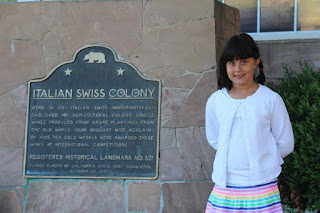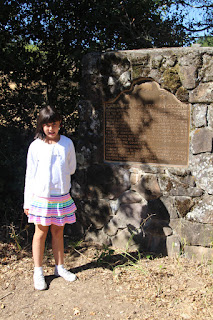They planted grapes from the Old World and made wine that earned awards at the international level.
While these grapes probably aren't from the original 1881 plantings-- we still had to stop for a quick photo.
I also take after my mother who takes photos of every pretty flower she sees :)
The next Asti site was on the side of the road-- and we accidentally passed it since we thought it was on the right side of the road. The Icaria-Speranza Commune (CHL 981) was another Utopian community.
French philosopher Etienne Cabet encouraged his followers to try cooperative living in an agrarian economy. They established seven colonies in the US-- this particular one beginning in 1881 and ending in 1886.
The plaque is located where the schoolhouse once stood for the community-- but there is nothing there any longer.
The next site has no plaque-- and its location makes it a little challenging to get great photos. Frog Woman Rock also known as Squaw Rock (CHL 549) is a volcanic monolith alongside of Hwy 101.
This rock is known for two Native American legends. The first is a Pomo legend about a woman with a beautiful face but the body of a frog. She was married to Coyote-- a famous trickster. She lived in this mountain, would trick men into pleasuring her, and then devour them. It was said that she could jump up to 100 feet to snatch the men. This legend was written down by John Hudson, whose home we will visit next.
The other legend is about a woman Sotuka who was promised by Cachow that they would marry. He changed his mind and married another woman. While Cachow and his new bride slept along the banks of the Russian River, Sotuka climbed to the top, held a rock and jumped on top of them-- killing all three of them. Both stories shocked Libi, "Why would anyone do those things?" but they were fascinating to learn about!
A short drive to Ukiah we came to the Sun House (CHL 926). This was the house built in 1911 by John and Grace Hudson.
The house wasn't open for tours until noon, but the docent let us onto the grounds so we could at least get photos with the plaque...
and the front of the house.
This is an example of Craftsman style redwood home which incorporated northwestern designs-- according to the state.
It was designed by architect George Wilcox and the Carpenters.
There is a great museum that we were able to go through which has a great deal of information about the Hudsons and their families.
Grace Hudson was an artist who was very famous for her paintings of Native Americans.
Her husband John was originally a physician who became fascinated with the Pomo natives that lived around Ukiah. Interestingly the Pomo wasn't a tribe, but a group of many tribes who lived in the same region and interacted.
John and Grace spent a great deal of time gathering stories and articles from the Pomo.
Happily you can now see a great sampling of their artifacts on permanent display in the museum.
The next Ukiah site is the Ukiah Vichy Springs Resort (CHL 980). This was very well labeled to prevent us from going into the surrounding neighborhoods as the directions from the state initially sent us.
These springs were discovered by Frank Marble in 1848 and a resort was established here in the 1850s. It is so named because it highly resembles the springs in Vichy, France.
Vichy Springs is the oldest, continually operating mineral springs in California-- you can still soak here today!
We had lunch at a little sandwich place called the Loose Caboose Cafe.
The sandwiches were yummy and the place was packed. If you intend to eat here you can call ahead, reserve a table, place your order, and when you arrive they immediately bring your food out to you. All the locals did this-- we did not, so we were lucky to find a table!
Outside they have some flowers that I felt the need to photograph.
Interestingly the Office of Historic Preservation has a very different write up then what's on the plaque. They say: This valley was discovered by Frank M. Azbill, who arrived from Eden Valley on May 15, 1854. During the same year, Charles Kelsey from Clear Lake also visited it and George E. White sighted it from Blue Nose.
However the plaque reads: The first inhabitants of Round Valley were the Yuki who resided here for thousands of years in harmony with their natural surroundings. In 1854, European settlers entered the valley. In 1856, conflicts between settlers and Yuki escalated and to protect local tribes the entire watershed was designated a reservatiin. Additional tribes were subsequently forced on the property: Monlacki, Wylaki, Lassik, Sinhtone, Pomo (including Cahto, Kabeyo, Shodakai, Yokayo, Shokawa, Shanel, Kashaya, and Habenapo among others), Wappo, Concow Maidu, Colusa, and Achumawi. In 1864, the government reduced the reservation by four-fifths, to its current size.
As the resident pointed out-- Round Valley has an auspicious history. A site of massive Native American relocation, now a haven for illegal, foreign marijuana dealers. She lamented the decline of the community she once loved and all we could do was stand and listen to her sad tale.
It is small and family owned and pretty darn cute.
Since the hotel doesn't have a pool, we spent our evening time seeing Inside Out at the local theater.
It was opening night and seeing it in this sweet little theater was a fun memory for us all.
We spent the night in jail in Willits-- that is, in the jail-themed room.
I'm happy to report that we all survived a night in jail and we are ready to find more sights.




















































0 comments:
Post a Comment